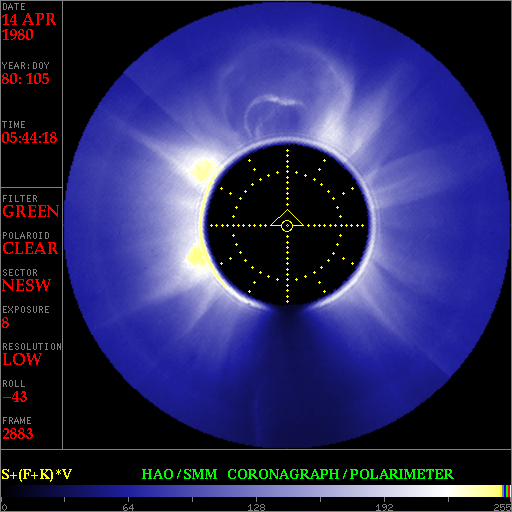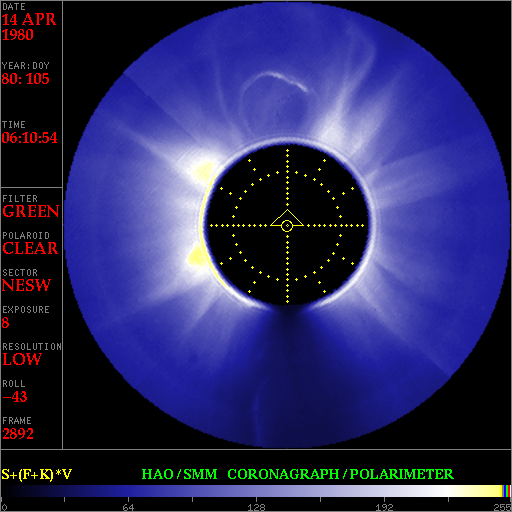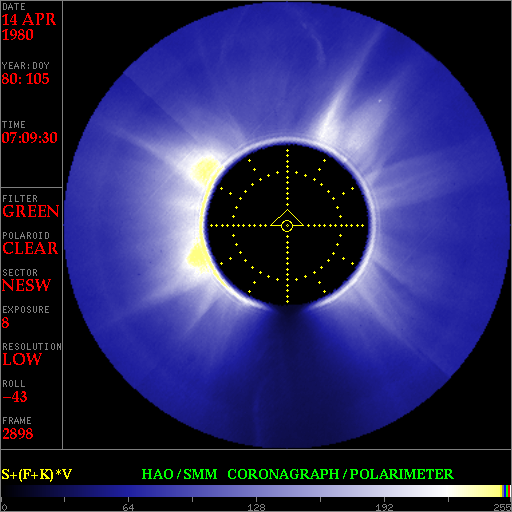SMM Coronagraph/Polarimeter
The Coronagraph/Polarimeter (C/P) aboard the SMM satellite was provided by HAO to study the relationship of the corona to the flare process. The C/P used an arrangement of multiple internal and external occulting discs to block out the direct light from the Sun's photosphere, thereby permitting the faint light of the Sun's outer corona to be recorded.
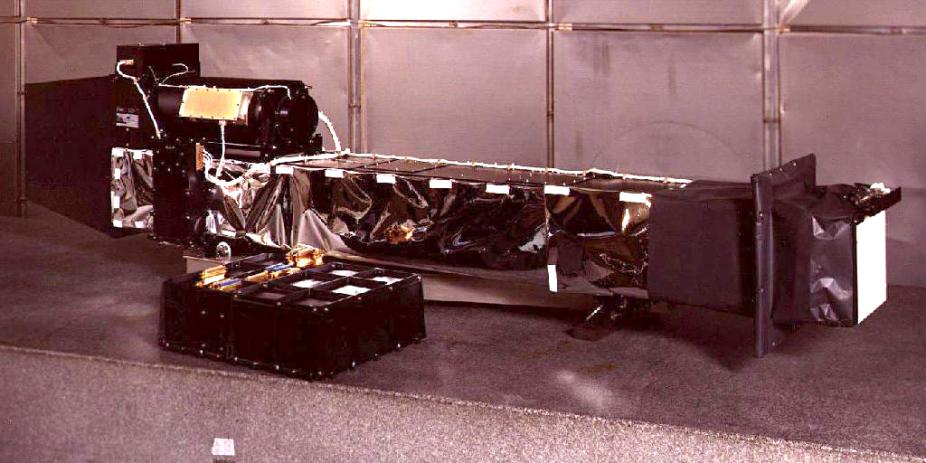
SMM Coronagraph.
DATA AND DATA PRODUCTS
Our SMM pages contains data access links, CME gallery and catalog, and coronal synoptic maps.
IMAGE QUADRANTS
The telescope produced an image of the corona with a square field of view extending from approximately 1.6 solar radii to 4.1 solar radii at the sides and out to just over 6.0 solar radii along the diagonals. A sector mirror directed the image of one "quadrant" of the corona to the vidicon detector, as shown below.
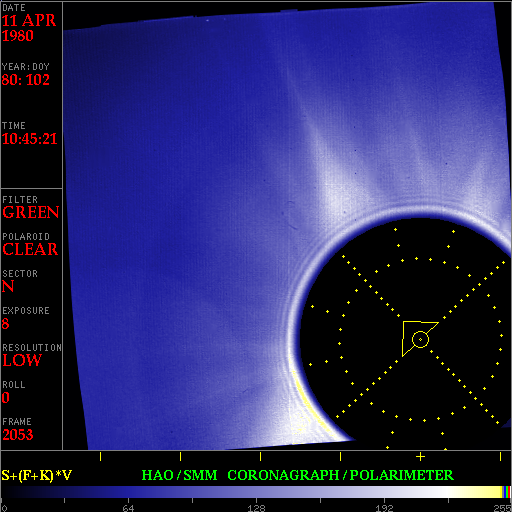
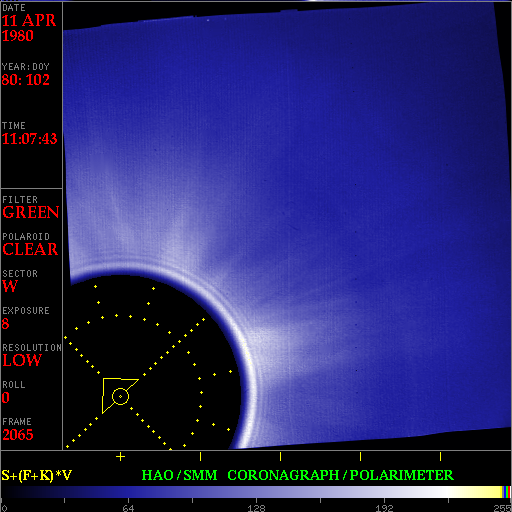
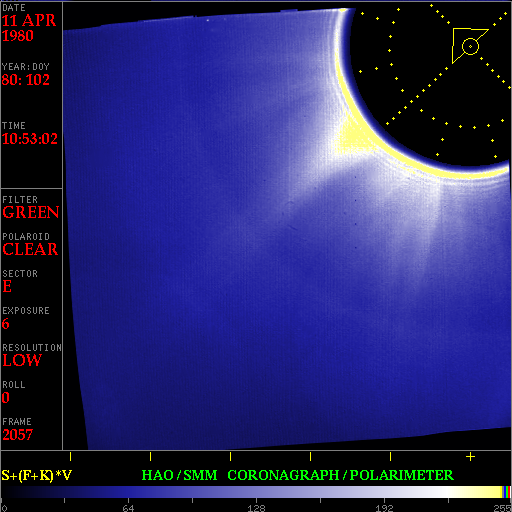
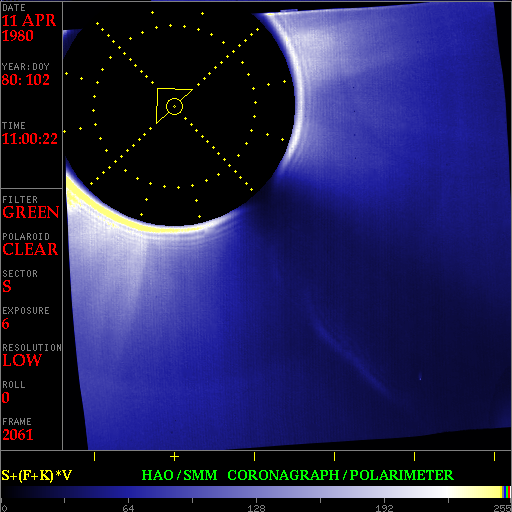
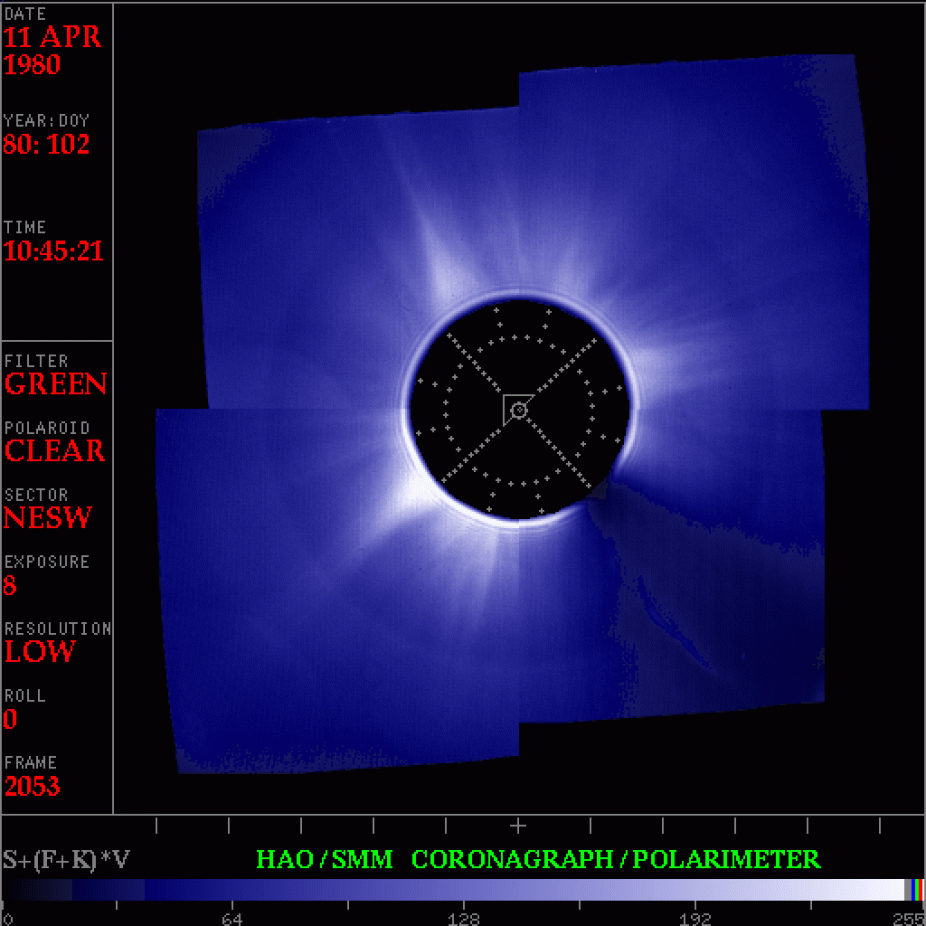
SMM stitched quadrant image
A full view of the corona (excluding the pylon shadow) could be obtained by rotating the sector mirror through four orthogonal quadrant positions. Images of each quadrant may be 'stitched' together via software, as shown to the right and below , to form a 4-quadrant composite image. In the normal spacecraft orientation, the south polar region of the Sun's corona was obscured by the shadow of a pylon which supports the occulting disk assembly. The intensity of coronal features within about 20 degrees of the center of this pylon shadow was greatly attenuated. To uncover the south polar regions of the corona, the spacecraft was rolled 90 degrees for a single orbit several times each week. This was done occasionally in 1980, and on a regular basis during the period 1984-1989.
SPATIAL RESOLUTION
Images were frequently taken at a high spatial resolution of ~6 arc seconds during March, 1980, and immediately following the repair in 1984. However, the normal mode of observation produced coronagraph images in low resolution mode, wherein the spatial resolution (pixel size) was ~12 arc seconds.
OPTICAL FILTERS
The instrument package contained several spectral filters to meet the mission objectives. Most of the coronagraph images were obtained through a wideband filter in the "green" portion of the visible spectrum (half-power bandpass 500 -> 535 nm). During 1980, images were occasionally obtained through a very narrow bandwidth interference filter (530.0 -> 530.6 nm) containing the forbidden emission line of Fe XIV. Two coronal mass ejections have been identified in this bandwidth in the 1980 data set and are noted in the SMM Coronal Mass Ejection Catalog. Prior to 1987, a limited number of images were also obtained through a narrow bandpass filter (654.3 -> 658.3 nm) centered on the H-Alpha emission line of neutral hydrogen.
Three polarizing filters (with polarization planes oriented at 60 degree angles) were used to analyze the polarization of the observed radiation, both on a daily basis for synoptic purposes, and (when activity warranted) intermittently several times per day.
DUTY CYCLE
The "duty cycle" for the detection of coronal mass ejections by this instrument during the 1980 operations was quantified by Hundhausen et al. (1984), and was based on the average speed of mass ejections through the telescope's field of view. A minimal observing cycle for the detection of most mass ejections required that at least one complete set of images in the four quadrants be obtained during each SMM orbit (~90 minutes). During the 1980 operations, a selected quadrant was often observed for a prolonged period following a flare alert. As a result, images of the other three quadrants were not obtained. The 1980 duty cycle for mass ejection detection was quite low; in fact, images of all four quadrants were obtained in only 28% of the orbits.
With the resumption of observations in June, 1984, a change of observing philosophy was instituted, and nominal operations included at least one complete set of images from three quadrants (north, east, west) during each orbit. The south quadrant was added to this nominal sequence in August, 1984. The instrument's duty cycle for all years following the 1984 repair was quite high, with complete coverage averaging 78% of the available orbits each year. (Annual values for the duty cycle have been published by MacQueen and St.Cyr, 1991.)
IMAGE QUALITY
The quality of the coronagraph images is typically compromised by the existence of 3 dark lines and a dark spot, all of which were caused by a electronics problems in the readout beam for the vidicon detector. In additon, there are several small, bright dots, which are caused by pinholes in the detector. Finally, there are 5 rows of small, dark registration (reseau) dots. All of the above "artifacts" appear at nearly constant positions, although the widths of the readout beam blemishes vary in size somewhat from one image to the next.
Following the 1984 repair, the instrument experienced sporadic periods of degraded image quality. The degraded images appear to have dark and bright horizontal streaks randomly placed throughout the image. This streaking problem appeared for periods ranging from a few minutes to several weeks, and the effects on the identification of features (such as mass ejections) ranged from minor to severe. The horizontal streaking was probably caused by an on-board electronics problem; however, no correlation with any operational or environmental parameter was ever discovered.
CALIBRATION
The calibration of SMM data is documented in this paper. The figures and cover page are in this directory.
The SMM instrumental stray light and vignetting functions are available in graphic form and software is available to reproduce these graphics.
The f-corona model (the scanned technote), used for SMM, was developed by Munro, R. and modified for the Skylab mission. Software is provided to reproduce this graphic.
REFERENCES
Hundhausen, A.J., C.B. Sawyer, L. House, R.M.E., Illing, and W.J. Wagner 1984, J Geophys Res 89 2639
MacQueen, R.M., A. Csoeke-Poeckh, E. Hildner, L.L. House, R. Reynolds, A. Stanger, H. TePoel, and W.J. Wagner, 1980 Solar Phys, 65, 91-107
MacQueen, R.M. and O.C. St.Cyr, 1991 Icarus, 90, 96-106
Woodgate, B.E. and S.P. Maran, 1986, Space Station Automation II, SPIE Conference Proc. 729, 202
SMM Data Use Policy
The use of SMM C/P images for public education efforts and non-commercial purposes is strongly encouraged and requires no expressed authorization. However, it is requested that any such use properly attributes the source of the images as: "Courtesy of HAO/SMM C/P project team & NASA. HAO is a division of the National Center for Atmospheric Research, which is supported by the National Science Foundation."
Acknowledgements
The Solar Maximum Mission Coronagraph/Polarimenter was designed & operated by the High Altitude Observatory, a division of the National Center for Atmospheric Research, and funded by the National Science Foundation. The SMM Coronagraph/Polarimeter instrument was built by Ball Aerospace Systems Division. The SMM Spacecraft was built by Goddard Space Flight Center, and the SMM project was funded & managed by the National Aeronautics & Space Administration.
